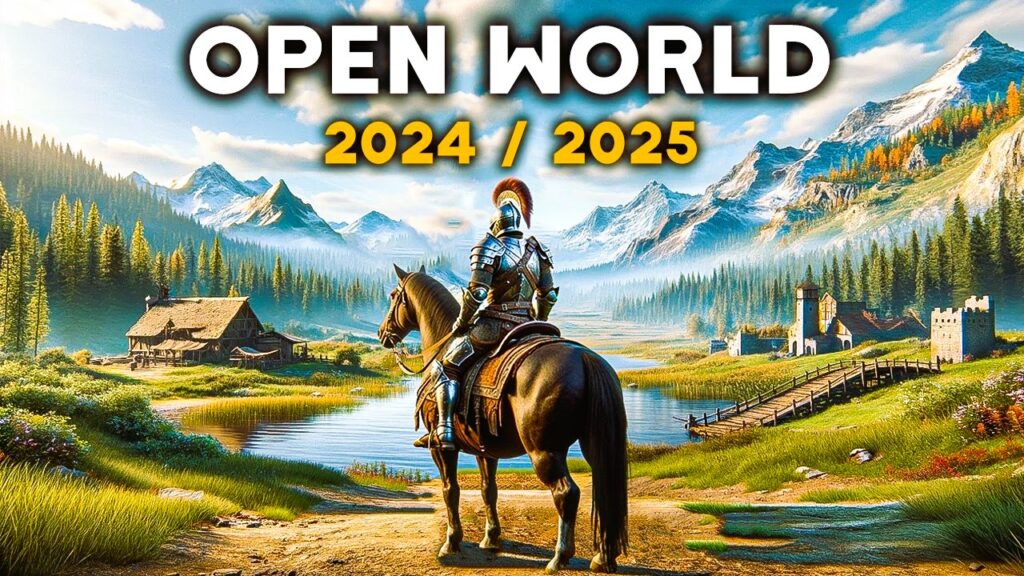Open-world games have become a cornerstone of modern gaming, captivating players with expansive worlds, freedom of exploration, and engaging narratives. From humble beginnings to the visually stunning and mechanically complex games of today, open-world titles have evolved into a genre that continues to push boundaries. Let’s delve into the history, key features, and enduring appeal of open-world games.
1. The Origins of Open-World Games
The concept of open-world gaming dates back to the early days of video games, where titles like Adventure (1980) on the Atari 2600 introduced players to non-linear gameplay. Although rudimentary by today’s standards, these early games laid the groundwork for the freedom-focused experiences we now associate with the genre.
As technology advanced, the 1980s and 1990s saw titles like The Legend of Zelda and Elite introduce vast game worlds, giving players the ability to explore at their own pace. These games became pioneers of the open-world genre, emphasizing exploration and player choice over rigid, linear storytelling.
Learn more about early open-world games on the Open-World Games page on Wikipedia.
2. The Rise of 3D Worlds

The transition to 3D gaming in the late 1990s marked a significant leap for open-world games. Titles like Grand Theft Auto III (2001) redefined the genre by combining a fully realized 3D world with a rich narrative, creating a seamless experience where players could explore, engage in missions, or simply roam freely. An exploration of the role of narrative in modern video games, see this link for more details.
Key Innovations During This Era:
- Interactive Environments: Players could interact with NPCs, vehicles, and objects, adding depth to the world.
- Dynamic Storytelling: Missions and side quests provided a sense of agency, allowing players to shape their own experiences.
- Sandbox Elements: Games like The Elder Scrolls III: Morrowind introduced worlds teeming with lore and exploration opportunities, solidifying open-world games as immersive escapades.
3. Expanding Horizons: The Modern Era of Open-World Games
The 2010s ushered in an era of unprecedented technological advancements that allowed developers to create larger and more detailed game worlds. Titles like The Witcher 3: Wild Hunt and Red Dead Redemption 2 showcased what open-world games could achieve with cutting-edge graphics, complex AI, and emotionally resonant narratives.
Modern Features That Define Open-World Games:
- Realistic Ecosystems: Dynamic weather systems, wildlife, and NPC behavior create lifelike environments.
- Freedom of Choice: Players can pursue main storylines, engage in side activities, or simply explore the world for hidden treasures.
- Cooperative and Multiplayer Modes: Games like GTA Online expanded open-world experiences by integrating multiplayer elements, fostering social interactions in virtual spaces.
4. What Makes Open-World Games So Engaging?
The allure of open-world games lies in their ability to offer a personalized experience. Every player’s journey is unique, shaped by their choices, playstyle, and exploration.
Freedom and Exploration
Open-world games excel at offering players freedom to carve their own paths. Whether scaling mountains in The Legend of Zelda: Breath of the Wild or uncovering ancient secrets in Assassin’s Creed: Odyssey, exploration becomes a reward in itself.
Immersive Storytelling
Open-world games integrate storytelling seamlessly into gameplay. Players don’t just witness events—they actively shape them. Games like Cyberpunk 2077 allow players to influence outcomes, adding a layer of immersion that linear games often lack.
Endless Replayability
With countless activities, side quests, and collectibles, open-world games keep players coming back for more. Procedural generation, as seen in No Man’s Sky, ensures that no two playthroughs are the same.
5. Challenges in Open-World Game Development
Despite their popularity, creating open-world games is no small feat. Developers face challenges like ensuring performance optimization, maintaining player engagement, and balancing expansive worlds with meaningful content.
Common Pitfalls in Open-World Games:
- Repetitive Content: Filler side quests can detract from the overall experience.
- Technical Limitations: Larger worlds often come with performance issues like frame rate drops or glitches.
- Overwhelming Scope: Some players may find vast game worlds intimidating or difficult to navigate.
6. The Future of Open-World Gaming

As technology continues to advance, the future of open-world games looks brighter than ever. Developers are leveraging tools like AI and machine learning to create smarter NPCs and more dynamic environments. Virtual reality (VR) and augmented reality (AR) are also poised to bring a new level of immersion to open-world gaming.
Trends to Watch:
- Cloud Gaming: Services like Xbox Cloud Gaming are making open-world games accessible across devices.
- AI Integration: AI-driven NPCs and adaptive storylines will enhance player immersion.
- Interactive Storytelling: Games like Starfield aim to combine space exploration with intricate narratives, offering unparalleled freedom.
The evolution of open-world games has redefined how we experience interactive entertainment. From the pixelated adventures of the 1980s to the sprawling, lifelike worlds of today, open-world games continue to captivate players by offering freedom, immersion, and endless possibilities.
As technology advances, the genre will undoubtedly continue to push boundaries, offering richer experiences and more engaging stories. Whether you’re a casual player or a hardcore gamer, the future of open-world gaming promises to be an exciting journey.
Are you ready to explore the limitless possibilities?





